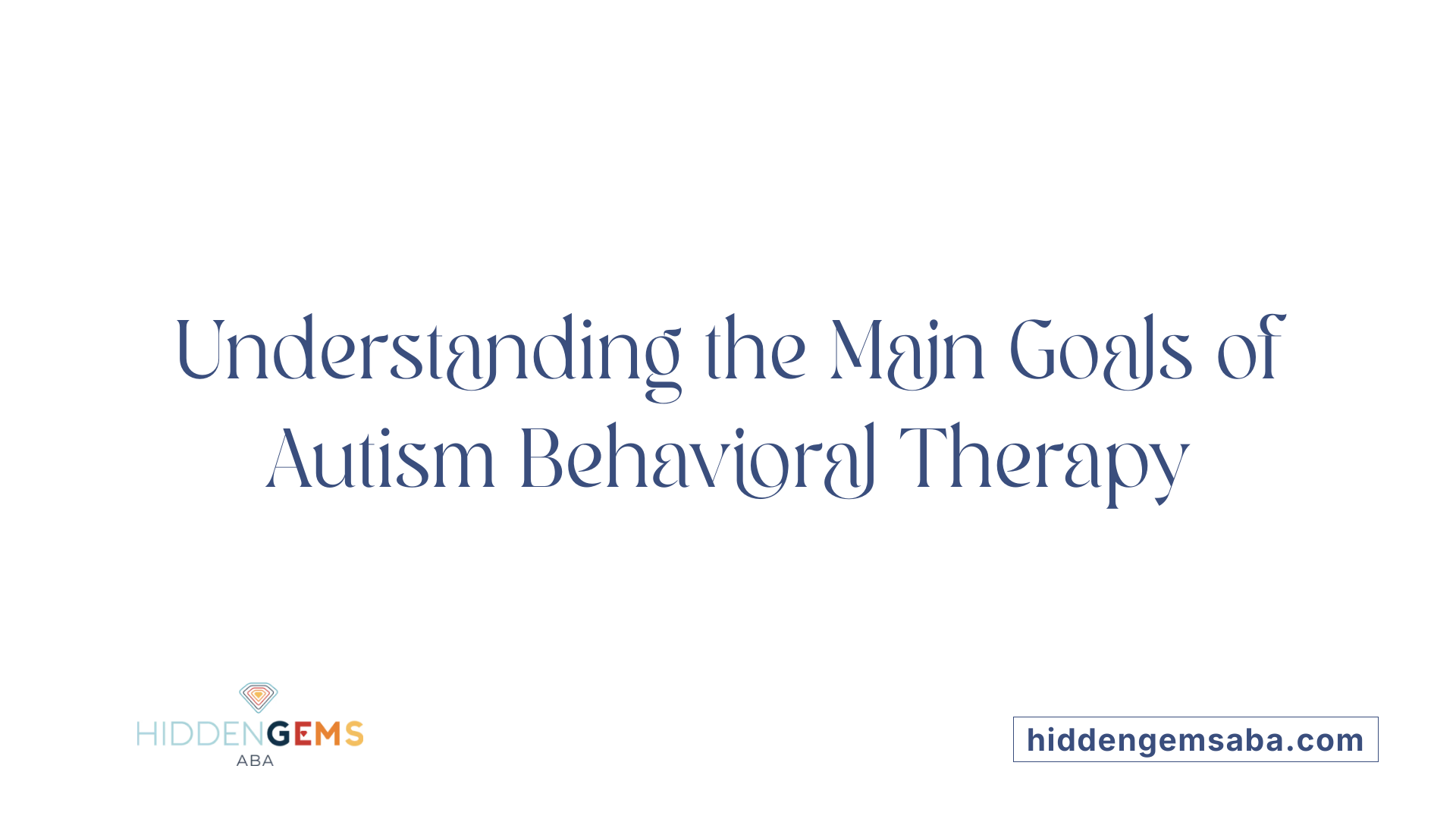Understanding the Role and Impact of ABA Therapy
Applied Behavior Analysis (ABA) therapy is the cornerstone of behavioral intervention for autism spectrum disorder (ASD). This evidence-based approach applies the science of learning and behavior to help individuals, particularly children with autism, develop essential communication, social, and daily living skills. Becoming a behavioral therapist in this field requires a comprehensive understanding of behavior therapy principles, rigorous education, certification, and practical experience, all aimed at delivering effective and individualized care to those with autism. This article explores how to embark on a career as a behavioral therapist specializing in autism, detailing the therapy’s foundations, practitioner roles, educational pathways, certification processes, and career prospects.
What Is Applied Behavior Analysis (ABA) Therapy and Its Role in Autism Treatment?

Definition of ABA therapy
Applied Behavior Analysis (ABA) therapy is a scientifically supported approach used primarily to address behavioral and developmental disorders. Rooted in the principles of behaviorism, ABA focuses on understanding and improving behaviors by modifying environmental factors. It is most notably employed to support individuals diagnosed with autism spectrum disorder (ASD).
Scientific foundation of ABA
ABA’s foundation lies in behaviorism, which asserts that all behaviors are learned and can be altered through environmental changes. This concept stems from classical conditioning discovered by Ivan Pavlov and operant conditioning introduced by B.F. Skinner. These methods form the basis for ABA’s behavior modification strategies.
Use of ABA in autism treatment
In treating autism, ABA therapy is customized to help develop essential skills such as communication, social interaction, and daily living abilities. Therapists assess each client’s unique needs and use personalized plans to teach appropriate behaviors while reducing those that are problematic or potentially harmful. This individualized attention is usually provided by Board Certified Behavior Analysts (BCBAs) who supervise therapy teams.
Techniques and strategies in ABA
ABA employs evidence-based techniques including positive reinforcement to encourage beneficial behaviors and various structured teaching methods like discrete trial training and pivotal response training. Therapists use ongoing data collection to monitor progress and adjust strategies, ensuring interventions remain effective and responsive to the client’s evolving needs.
Effectiveness and research support for ABA
Since its introduction in the 1960s, ABA therapy has been extensively studied and consistently demonstrated improvements in language, social skills, and cognitive functions among children with autism. These studies support ABA as an effective intervention, contributing to its status as a widely accepted therapeutic approach.
Modern developments in ABA emphasizing neurodiversity
Contemporary ABA practices increasingly focus on strength-building, fostering positive social interactions, and respecting neurodiversity, moving beyond only reducing problematic behaviors. Therapists aim to enhance quality of life by encouraging engagement and self-expression, adapting traditional methods to align with modern ethical perspectives.
| Aspect | Description | Additional Detail |
|---|---|---|
| Scientific Basis | Behaviorism, classical and operant conditioning | Pavlov (classical), Skinner (operant) |
| Main Use | Autism treatment and other behavioral/developmental disorders | Also used for ADHD, brain injury, dementia |
| Techniques | Positive reinforcement, discrete trial training, pivotal response training | Skill-building and behavior reduction methods |
| Professional Oversight | Led by Board Certified Behavior Analysts (BCBAs) | Requires graduate education and supervised experience |
| Evidence of Effectiveness | Supported by multiple studies since 1960s | Improvements noted in language and social behaviors |
| Modern Focus | Respect for neurodiversity and strengths-based approaches | Emphasizes positive social skills and quality of life |
Who Provides ABA Therapy for Individuals with Autism?

Roles of BCBAs and RBTs
ABA therapy for individuals with autism is primarily provided by certified professionals. The Board Certified Behavior Analyst (BCBA) is the lead expert responsible for designing, overseeing, and modifying treatment plans tailored to each client's unique needs. They ensure that evidence-based ABA techniques are applied effectively.
Registered Behavior Technicians (RBTs) work under the supervision of BCBAs to deliver the day-to-day therapy sessions. RBTs implement specific interventions, such as positive reinforcement and skill-building strategies, directly with clients.
Responsibilities of ABA Therapists
ABA therapists perform several critical tasks, including assessing behavioral challenges, developing individualized treatment plans, applying behavioral interventions, monitoring client progress, and adjusting techniques as needed. They help develop social, communication, and daily living skills while reducing problematic behaviors.
Collaboration with Families and Stakeholders
Family involvement is essential in ABA therapy. Therapists and BCBAs collaborate closely with family members and other stakeholders to ensure interventions are consistent and supportive across settings. This team approach improves treatment effectiveness and generalization of skills.
Supervision and Team Approach in ABA Delivery
ABA therapy is usually practiced in clinics, schools, or healthcare settings under the supervision of a BCBA. This oversight guarantees quality control and adherence to ethical standards, as well as ongoing professional development for therapists implementing the interventions.
Importance of Credentials and Professional Training
To provide high-quality ABA services, professionals must attain specific credentials. Becoming a BCBA requires earning a master’s degree in behavior analysis or a related field, completing 1,500–2,000 supervised hours, passing a certification exam, and maintaining licensure through continued education. These qualifications ensure that providers are equipped with up-to-date, evidence-based knowledge and skills to support individuals with autism effectively.
Core Goals of Behavioral Therapy in Autism Treatment

What are the main goals of behavioral therapy in autism treatment?
Behavioral therapy for autism primarily aims to improve communication skills, enhance social interactions, and foster greater independence in daily living. These therapies focus on teaching new, beneficial behaviors while reducing problematic or harmful ones through structured, personalized approaches.
The therapy supports skill development across multiple areas, including language acquisition, socialization, and adaptive routines needed for everyday life. By emphasizing motivation and engagement via positive reinforcement, therapists help children with autism achieve essential functional abilities.
Reducing problematic behaviors such as stimming or aggression is also a critical goal. This is done by identifying environmental triggers and applying evidence-based strategies to promote positive alternatives.
Ultimately, behavioral therapy strives to improve the overall quality of life for children with autism. It supports their ability to communicate, connect socially, manage daily tasks independently, and thrive within their community.
Key Focus Areas in Autism Behavioral Therapy
- Improving Communication Skills: Teaching verbal and nonverbal communication to express needs and emotions.
- Enhancing Social Interactions: Encouraging positive social behaviors and empathy development.
- Increasing Independence: Building skills for self-care, daily routines, and decision-making.
- Reducing Problematic Behaviors: Using reinforcement and behavior modification to decrease harmful actions.
- Skill Development and Motivation: Applying positive reinforcement to foster learning and engagement.
- Promoting Quality of Life: Helping children integrate more fully and happily into family, school, and community life.
These goals are pursued using methods rooted in Applied Behavior Analysis (ABA) and other evidence-based behavioral practices, ensuring tailored, effective support for each child's unique needs.
Educational Pathways to Becoming a Behavioral Therapist for Autism
Relevant Bachelor's Degrees
To begin a career in behavioral therapy focusing on autism, aspiring therapists typically pursue a bachelor's degree in psychology, special education, or a related field. This foundation equips students with fundamental knowledge of human behavior and developmental challenges crucial to understanding the needs of individuals with autism.
Importance of Master's Degree in ABA or Related Fields
Most professional roles in Applied Behavior Analysis (ABA) therapy require advancing to a master's degree. Graduate programs emphasize behavioral science with a focus on ABA, preparing students to apply evidence-based techniques effectively. This advanced education is essential for certification and competent practice.
Verified Course Sequence (VCS) Requirements
An important component of educational preparation is completing a Verified Course Sequence (VCS) in ABA. The VCS ensures that coursework meets the educational requirements established by the Behavior Analyst Certification Board (BACB). It covers subjects such as behavior assessment, intervention strategies, and ethical considerations.
Graduate Certificates and Post-Master’s VCS Options
For those whose master's degrees did not include the necessary ABA coursework, graduate certificate programs or post-master’s VCS options provide pathways to fulfill these requirements. These specialized programs allow professionals to meet certification standards without pursuing a full second degree.
Universities Offering ABA-Specific Programs
Several universities offer targeted ABA programs that fulfill certification prerequisites. Drexel University, for example, provides both a Master of Science in Applied Behavior Analysis and a certificate program. These offerings include the required coursework for BACB certification and are designed to support career advancement in behavioral therapy for autism.
Certification Process: Becoming a Board Certified Behavior Analyst (BCBA)

Role and Importance of BCBA Certification
Becoming a Board Certified Behavior Analyst (BCBA) is essential for those who want to provide independent behavior-analytic services, especially in autism and related developmental disorders. BCBAs are qualified to design and oversee Applied Behavior Analysis (ABA) programs, supervise therapists, and collaborate with families and stakeholders to ensure effective treatment.
Eligibility Criteria and Supervised Fieldwork Hours
To be eligible for BCBA certification, candidates must earn a master's degree in behavior analysis, psychology, education, or a related field that includes ABA coursework verified by the Verified Course Sequence (VCS). Additionally, candidates are required to complete between 1,500 and 2,000 hours of supervised fieldwork under a qualified BCBA or equivalent professional. Specific hours and requirements may vary depending on the state.
Passing the BACB Certification Exam
After meeting educational and supervised experience prerequisites, candidates must pass the BACB certification exam. This exam tests knowledge of behavior analysis principles, application techniques, and ethical considerations crucial for clinical practice.
Maintaining Licensure Through Continuing Education and Ethics Adherence
BCBAs must maintain their certification by fulfilling ongoing continuing education requirements and adhering to professional ethical standards. This ensures up-to-date knowledge and quality care for clients.
Doctoral Level Credential (BCBA-D) Details
For those holding a doctoral degree, the BCBA-D credential offers recognition of advanced expertise in behavior analysis. Applicants for the BCBA-D must meet similar eligibility and examination criteria but also fulfill additional academic and professional requirements.
State-Specific Licensure Requirements
Many states require BCBA certification as a condition for licensure in behavior analysis. Licensing regulations vary, with some states linking licensure directly to BCBA certification, making it imperative for practitioners to understand and comply with the rules of their jurisdiction.
Practical Experience and Supervised Training

How many supervised field experience hours are required?
To become proficient in ABA therapy, trainees must complete between 1,500 and 2,000 hours of supervised field experience. This comprehensive on-the-job training is essential for developing the practical skills needed to assess behavior, design interventions, and monitor client progress effectively.
In what settings is supervised training typically conducted?
Supervised training occurs across a range of environments including clinical facilities, educational institutions, and healthcare settings. These varied contexts provide trainees with exposure to diverse client needs and treatment scenarios, preparing them for versatile professional roles.
What role does mentorship and supervision play?
Mentorship is a fundamental component of supervised fieldwork. Board Certified Behavior Analysts (BCBAs) or other qualified professionals closely guide trainees, offering feedback and oversight. This collaborative environment ensures that emerging therapists apply evidence-based techniques correctly and ethically.
What hands-on skills do trainees develop?
During supervised experience, trainees hone practical skills such as conducting behavior assessments, implementing behavior intervention plans, utilizing positive reinforcement strategies, and systematically monitoring treatment outcomes. These competencies are critical for delivering effective ABA services.
How does supervised experience relate to licensing?
Many states require documented supervised field experience hours as part of the licensure process for ABA practitioners. Successfully fulfilling these requirements is crucial for eligibility to sit for the BCBA certification exam and for obtaining professional licensure, which authorizes independent practice.
| Aspect | Details | Importance |
|---|---|---|
| Supervised Hours | 1,500-2,000 hours supervised by qualified professionals | Ensures readiness and competence |
| Training Settings | Clinical, educational, healthcare environments | Provides real-world experience across contexts |
| Mentorship Role | Supervised by BCBAs or qualified mentors | Guides correct and ethical application |
| Practical Skills | Behavior assessment, intervention, progress monitoring | Develops core competencies for effective therapy |
| Licensing Implication | Required for exam eligibility and licensure | Validates professional qualifications |
Career Prospects, Settings, and Salary Expectations

Where Do ABA Therapists Typically Work?
ABA therapy professionals find employment across various settings, including clinics, schools, private practices, and healthcare facilities. These environments provide opportunities to work directly with clients, develop treatment plans, and collaborate with interdisciplinary teams. Many educational institutions integrate ABA services for students with developmental disorders, while clinical and healthcare settings handle a broader range of behavioral issues.
What Are the Different Job Roles in ABA Therapy?
Career roles in ABA therapy range from Registered Behavior Technicians (RBTs), who implement treatment plans under supervision, to Board Certified Behavior Analysts (BCBAs), who design and oversee behavioral interventions. The doctoral-level designation, BCBA-D, is available for highly specialized practitioners involved in advanced research and leadership.
How Much Do ABA Therapists Earn?
In the United States, the median annual salary for ABA therapists is around $42,088, though this varies based on experience, qualifications, specific roles, and geographic location. For example, a BCBA with board certification and considerable experience typically earns more than an entry-level RBT. Salaries also reflect the setting; private practices and specialized clinics may offer different compensation compared to public schools.
Are ABA Therapy Services Covered by Insurance?
ABA therapy services are often covered by private insurance plans and Medicaid, especially when prescribed as medically necessary. Coverage depends on individual insurance policies and state-specific Medicaid programs. This financial support enhances accessibility to therapy for children with autism and related behavioral disorders.
What Is the Demand and Outlook for Behavioral Therapists?
The demand for qualified behavioral therapists is growing due to increased awareness of autism spectrum disorder and related disabilities, along with expanded insurance coverage. Future job prospects appear promising, with ongoing developments in certification standards and educational programs ensuring the preparation of competent professionals to meet community needs.
Key Principles and Techniques of ABA Therapy

Behaviorism Foundations: Classical and Operant Conditioning
ABA therapy is grounded in the science of behaviorism, which posits that all behaviors are learned and can be modified by changing environmental factors. This foundation originates from classical conditioning, as demonstrated by Ivan Pavlov’s experiments with conditioned reflexes, and operant conditioning, a concept developed by B.F. Skinner in the 1930s which focuses on how consequences shape behavior.
Positive Reinforcement and Antecedent-Behavior-Consequence Analysis
A central technique in ABA therapy is positive reinforcement — rewarding desirable behaviors to increase their frequency. Therapists use antecedent-behavior-consequence (ABC) analysis to understand what triggers a behavior, the behavior itself, and the consequences that follow. This systematic approach allows for tailored interventions that encourage appropriate behaviors while reducing harmful or unwanted ones.
Specific ABA Techniques: Discrete Trial Training, Pivotal Response Training, Task Analysis
ABA employs several evidence-based methods including discrete trial training (structured teaching episodes), pivotal response training (targeting pivotal areas like motivation), and task analysis (breaking down complex tasks into smaller steps). These strategies support skill acquisition efficiently and promote generalization of learned behaviors.
Emphasis on Individualized Treatment and Data-Driven Decision Making
ABA programs are highly individualized to suit each client's unique needs. Therapists continuously monitor progress through data collection and adjust interventions based on measurable outcomes, ensuring treatment remains effective and responsive.
Addressing Complex Behaviors Like Stimming and Empathy Deficits
ABA therapy specifically targets challenging behaviors common in autism, such as repetitive stimming and difficulties with empathy. Using reinforcement strategies, the therapy promotes positive social interactions and skill development while reducing problematic behaviors safely and respectfully.
Accessing ABA Services: What Future Therapists Should Know

How Do Families Obtain ABA Therapy?
Families seeking ABA therapy typically start with a medical evaluation to diagnose behavioral or developmental disorders such as autism. This evaluation is essential for understanding the specific needs of the client and guiding appropriate treatment plans.
What Is the Role of Medical Evaluations and Insurance?
Once a diagnosis is confirmed, families usually need to verify insurance coverage. Many private insurance plans and Medicaid cover ABA therapy when it is prescribed as medically necessary. This involves submitting documentation and may require prior authorization from the insurance provider.
Who Are the Qualified Professionals Providing ABA Therapy?
ABA services are delivered by Registered Behavior Technicians (RBTs) who work directly with clients under supervision. The treatment programs are designed and overseen by Board Certified Behavior Analysts (BCBAs), who have graduate-level credentials in behavior analysis and hold certification through the Behavior Analyst Certification Board (BACB). These professionals ensure that therapy is tailored, ethical, and adheres to evidence-based practices.
How Does Insurance Coverage Work for ABA Therapy?
Coverage varies by state and insurance provider but often includes private insurance and Medicaid when therapy is deemed necessary. Therapists and families collaborate with insurance companies to complete approvals and maintain compliance for continued services.
Why Is Evidence-Based Treatment and Ethics Important?
ABA therapy follows scientifically supported methods proven to improve behavioral and developmental outcomes. The BACB enforces strict ethical standards requiring ongoing education and supervision to maintain certification. This ensures that interventions are not only effective but also respectful of the client's dignity and rights.
This coordinated process involving medical evaluation, insurance navigation, qualified providers, and a commitment to evidence-based, ethical care enables families to access high-quality ABA therapy.
| Aspect | Details | Importance |
|---|---|---|
| Medical Evaluation | Diagnosis by qualified clinicians | Foundation for treatment |
| Insurance Verification | Confirm coverage, submit authorizations | Enables financial support |
| Qualified Professionals | BCBAs design and supervise; RBTs implement | Ensures effective and ethical care |
| Evidence-Based Therapy | Uses validated ABA techniques | Leads to proven behavioral improvements |
| Ethical Standards | Maintained through BACB certification requirements | Protects client welfare |
Becoming a Dedicated Practitioner in Autism Behavioral Therapy
Embarking on a career as a behavioral therapist specializing in autism demands a strong foundation in behavioral science, rigorous academic and practical training, and a commitment to continual professional development and ethical practice. By understanding the principles of ABA therapy, gaining the necessary education and certification, and building experience through supervised practice, aspiring therapists equip themselves to make a meaningful impact in the lives of individuals with autism. As demand for qualified behavioral therapists grows, this rewarding career path offers both professional fulfillment and the opportunity to contribute to evidence-based, compassionate care that supports autonomy and development for those affected by autism.






